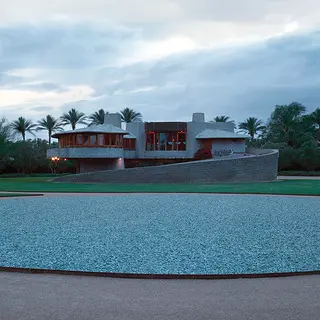
Praising Arizona: Midcentury Modern Treasure Trove
A skeptical traveler to metropolitan Phoenix discovers historical and cultural charm.
As a resident of Tucson, Arizona’s second city, I am required by local ordinance to hate Phoenix, our wealthier, larger neighbor to the north—to disparage it as a soulless, sprawling megalopolis with all the charm of an eternal paving project.
The only problem with this clear-headed and resolute conviction is that I go to Phoenix fairly often for work, and the more I’ve gotten to know the city, the more I’ve been forced to acknowledge a dirty little secret: Phoenix is kind of a funky, cultured, even livable place. I never thought I’d admit this about the big city to our north, but it’s actually pretty cool.
(I mean that metaphorically. Do not go in July without a radiation suit.)
It’s also popular. The greater metropolitan area, known as the Valley of the Sun, is visited by 16 million people a year. Most seem to come for two things: the sunshine and the golf. There is plenty of both, along with an abundance of otherworldly desert mountain scenery.
But Phoenix and its environs, particularly the adjoining city of Scottsdale, present additional opportunities. Both are rich in architectural history, cultural attractions, and a big-city urban ambience too easily missed by those who limit their stay to fairways and resort swimming pools.
Half-hidden within today’s metropolis is an older, smaller, and more intimate place, a 1950s community with landmark Midcentury Modern buildings and a faintly sun-bleached sense of that era’s high style, like Rat Pack Vegas before they tore it all down. That style can be seen in commercial buildings scattered throughout the city, including several now repurposed as pubs or restaurants. It also can be found in older neighborhoods, especially those built by Ralph Haver, a local architect whose signature was modestly sized homes with walls of glass, low-pitched roofs, and angled porch posts.

photo by: Mark Lipczynski
Local resident Sarah Seddon takes advantage of Phoenix’s sunny climate with a hike in the Camelback Mountain Echo Canyon Recreation Area.

photo by: Mark Lipczynski
The Sugar Bowl ice cream parlor and restaurant is listed on the Scottsdale Historic Register.

photo by: Mark Lipczynski
Guitars from around the world fill a gallery at the Musical Instrument Museum.
You can find Haver neighborhoods and similar highlights through ModernPhoenix.net, a website dedicated to Midcentury Modern design that has spurred growing interest in the city’s architectural heritage. The site was founded by Alison King, a graphic design professor who grew up in Phoenix but discovered her passion while studying in New York. “I realized that my spirit and soul is stuck in the 1940s,” she says, laughing, over lunchtime tacos at the Clarendon Hotel and Spa, a midtown example of the period she loves.
King believes the city remains underappreciated, even by area residents. “Phoenix is sprawling—you could spend your whole life in the suburb of Chandler with the Walgreens as your corner store,” she says. “It’s not until you really go into the city and explore that you understand there’s so much diversity and character here.”
“It’s not until you really go into the city and explore that you understand there’s so much diversity and character here.”
Alison King, founder of ModernPhoenix.net
My favorite place to stay in the area, the Hotel Valley Ho in Scottsdale, is a carefully renovated example of sleek midcentury design as filtered through a Southwestern lens (lots of glass, concrete panels with an arrowhead motif). Opened in 1956, it was co-owned by Robert and Evelyn Foehl, who previously operated a resort in Southern California that left them with connections to the Hollywood elite of the day.
The Valley Ho quickly became a getaway for the stars. Zsa Zsa Gabor rode horses there. Natalie Wood and Robert Wagner had their wedding reception in the hotel ballroom. Jimmy Durante used to play the piano late at night in the lobby. “The paparazzi would follow you to Palm Springs, but Scottsdale was too much of a pain in the butt,” explains Kristin Heggli, the Valley Ho’s public relations director.
When the Valley Ho was built, Scottsdale was a rural town of about 2,000 people. Today, downtown Scottsdale still has Old Western facades on some buildings and a couple of saloon-style bars, but it’s also home to dozens of art galleries as well as high-end shopping and dining. You can still buy a cowboy hat there, but you can also pick up artwork by Chagall or Salvador Dalí.If you’d like to combine your stay in a landmark hotel with more customary vacation pursuits, the Arizona Biltmore, a 39-acre resort not too far down the road, is another option. The Biltmore is often identified as a Frank Lloyd Wright building, but it was actually designed by Albert Chase McArthur, a student of Wright’s, with Wright serving as the consulting architect.
The Biltmore has the dramatic presence of a large-scale Wright building, however, and with two golf courses, lighted tennis courts, eight pools, a water slide for the kids, fitness classes of every kind, and even a life-size outdoor chess board, it’s the kind of activity-filled vacation spot many visitors are seeking.

photo by: Mark Lipczynski

photo by: Mark Lipczynski
Above: The 1956 Hotel Valley Ho blends Southwestern and Midcentury Modern influences. Below: Reminders of the area’s frontier past abound in Old Town Scottsdale.

photo by: Jim McMahon
Wright’s shadow hangs over much of Greater Phoenix’s historic architecture. He designed only 13 built structures in the area, but his students were involved in many others. For Wright acolytes, any visit to Phoenix starts with his winter residence and headquarters, Taliesin West. Now home to the Frank Lloyd Wright Foundation and the Frank Lloyd Wright School of Architecture, the National Historic Landmark sits on the edge of the McDowell Mountains outside Scottsdale.
Taliesin West is impressive, but it’s not my favorite Wright work in the city. That would be the relatively unknown David & Gladys Wright House. David was one of Frank Lloyd Wright’s eight children, and the house the elder Wright designed for him is based on a rising spiral that prefigures the design for New York’s Guggenheim Museum, while remaining more fanciful and human in scale. The spiral lifts the living quarters above the treetops so every room has panoramic, carefully framed views, while also letting spaces flow organically into one another.
The 1952 house fell out of the family’s hands after David’s wife, Gladys, died in 2008. It was eventually purchased by a developer who planned to demolish it to build high-end homes. Saving the Wright house became a cause for Phoenix’s preservation community and, after a series of close calls, Zach Rawling, a lawyer and custom home builder, stepped in to buy it in 2012. Rawling grew up only a short distance away, with a mother who loved architecture, and he remembers often riding his bike past the building, straining to get a look at it over a wall of foliage. On the day he gives me a tour, his enthusiasm is clear and unaffected. “The family never remodeled the interior, so we have every original board in the house,” he says. “There’s a huge amount of history here.”
The Wright house, located in the Arcadia neighborhood, is open for tours by appointment only, scheduled through its website. [UPDATE: The house is back on the market, as of March of 2019.] When you’re there, you’re in a part of the city where landmarks from an earlier time abound. Old Town Scottsdale, the Biltmore Fashion Park (an early mall), and the Arizona Biltmore are “all within five minutes down the road,” says Rawling, who used to bike in a loop past these places and along the Arizona Canal, a waterway that gave rise to much of the area’s development. “It’s all in this one corridor near the base of Camelback Mountain,” he says, adding that for visitors interested in getting a sense of the earlier city, “this is the heart of what they want to see.”
Online Extra: Another Example of Frank Lloyd Wright's Work

Learn how the David & Gladys Wright House, designed by dad Frank Lloyd Wright, came to be protected.

photo by: Mark Lipczynski

photo by: Mark Lipczynski
The curving mahogany ceiling of the David & Gladys Wright House provides a warm counterpart to concrete-block walls.

photo by: Mark Lipczynski
The Cosanti Foundation’s Mary Hoadley admires the bronze bells made and sold at Cosanti.
Wright’s Arizona architecture connects deeply to the Sonoran Desert landscape that gives the region its character. Just a few miles from Taliesin West, another architect built Cosanti, a residence and studio that took that connection a step further. Paolo Soleri, who studied with Wright, lived there until he died in 2013 at age 94. Cosanti is a strange cross between a science fiction set and a hippie’s fever dream. The buildings are rounded, reminiscent of gigantic, half-buried snail shells. They were mostly constructed using an “earthcasting,” in which concrete was poured over earthen forms, with the dirt then excavated out, leaving its texture and shape behind.
The Italian-born Soleri is also famous for designing “windbells,” amalgams of mobiles, wind chimes, and bells cast in bronze and ceramic. While meandering through Cosanti’s gift shop, I handed my notebook to my 16-year-old daughter and jokingly told her to keep notes. At the end, I looked and she had written one word: “Bells.”
There are an awful lot of bells for sale at Cosanti. But the place is a bit more than that. Soleri was the creator of “arcology,” a philosophy that sought to integrate architecture with a devotion to ecological principles, and there’s something organic and weirdly wonderful about the forms these ideas gave birth to. To me, Cosanti, with its rounded earthen structures and multitude of bells, feels like a village for really musical hobbits. It’s worth the drive if you’re into that sort of thing, but it’s not really reflective of Phoenix, which, if we’re honest, was built in outright defiance of its desert environment.
As Phoenix grew, it also seemed in thrall to a particular Western obsession: valuing the comfort of automobiles over people. But attitudes are changing. In 2013, Phoenix ranked in the top 10 U.S. cities for energy-efficient building. And the metropolitan area also has done much to make itself welcoming to those of us who occasionally like to use our feet to get someplace.
A light-rail line first began operating in 2008 and runs from suburban Mesa through the heart of the city, with two extension lines in the works. Combined with a bike rental system at many of the stops, and a surprising number of pedestrian-friendly streets, downtown Phoenix is more welcoming than is generally realized. The Phoenix Art Museum and the Heard Museum, dedicated to Native American art and history, are both easily accessible through public transportation. They’re part of a rich collection of cultural attractions in a metropolitan area known mostly for resort and outdoor activities.
A personal favorite of mine is the Musical Instrument Museum, which includes more than 6,000 instruments from around the world, along with items belonging to icons such as Johnny Cash and John Lennon. It’s a hidden treasure in a place that, as much as this Tucsonan hates to admit it, is worth exploring. “I think there’s still a perception that this is a young city, but we’re well past our adolescence,” says King. “This is really a grown-up city.”
Online Extra: Under the Radar

Al Beadle helped define desert Modernist architecture. Learn more about his work and style.


